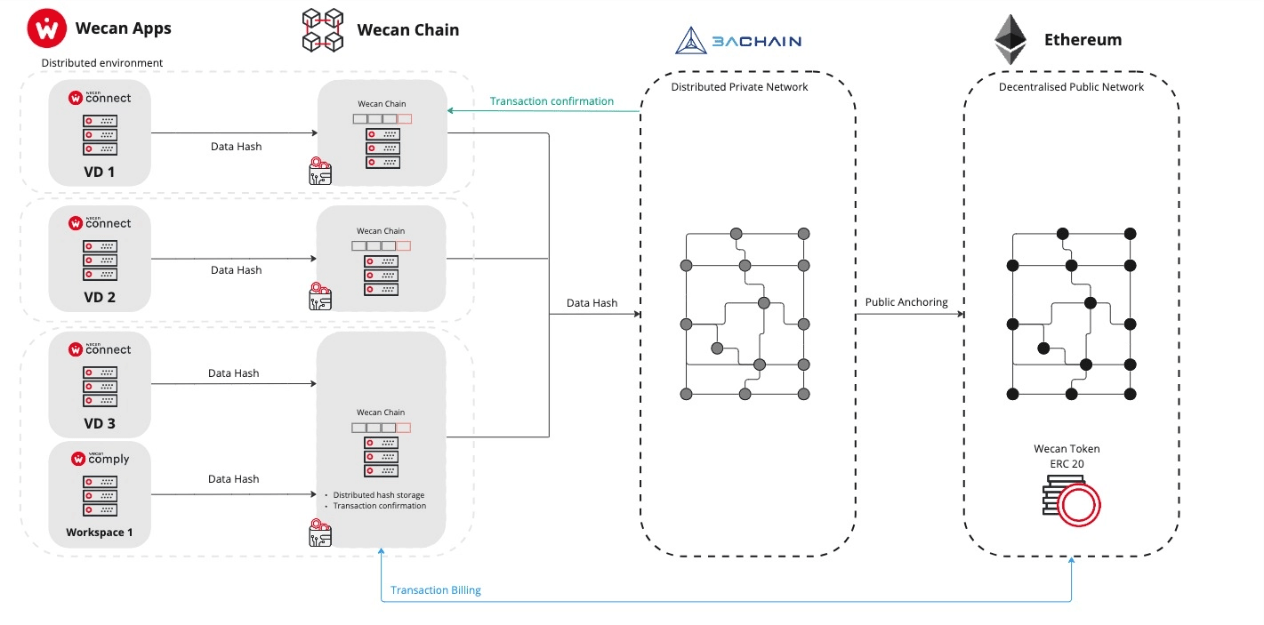Technology
R&D
Wecan has built a technological infrastructure with several layers, the fruit of lengthy R&D work, in particular with EPFL and Professor Rachid Guerraoui’s teams.
Co-financed by the Swiss Confederation, we analyzed the best possible architectures to meet the challenges of security, scalability and energy consumption. Visit our blockchain TestBed

How it works
1. Wecan App
Each WecanApp has distributed data storage and they communicate directly with an API to tokenize data and generate hashes enables to be “Blockchain-agnostic”.
2. Wecan Chain
A Transaction ID is generated by Wecan Chain and returned to the app, which publish a hash to 3AChain.
3. Layer 2: 3aChain
3aChain is a POA private blockchain. Wecan operates a simple and sign nodes here.
4. Base layer: Ethereum
Ethereum is a POS public blockchain. We issue our ERC 20 token on Ethereum and 3aChain anchors a daily root hash on it.

Global architecture

Base Layer: Ethereum
What is Ethereum?
Ethereum is an open-source, decentralized blockchain platform renowned for its smart contract functionality, which allows to write scripts that self-execute and handle the enforcement, management, performance and payment of agreements between parties.
We use this smart contracts for our applications which run on top of the Ethereum blockchain, opening up a world of possibilities.
Ethereum operates on a proof-of-stake (PoS) system through Ethereum 2.0 upgrade. The PoS model allow individuals to create blocks and validate transactions based on the amount of Ether (ETH, Ethereum’s native token) they hold and are willing to “stake” as collateral.

Benefits of using Ethereum as a platform to issue our ERC-20 utility tokens
Standardization
The ERC-20 standard has a well-defined set of rules that all tokens must follow. This includes how the tokens can be transferred, how transactions are approved, how users can access data about a token, and the total supply of tokens.
Interoperability
Due to this standardization, ERC-20 tokens are interoperable with a wide range of services on the Ethereum platform, including exchanges, wallets, decentralized exchanges, and other smart contracts.
Network Security
By using Ethereum, the Wecan token leverages the security of Ethereum’s network, one of the largest and most well-established blockchain networks.
Vibrant Ecosystem
Ethereum has a vibrant and active community of developers and users. This can make it easier to find resources for developing and promoting the token.
Smart Contract Functionality
Ethereum’s primary feature is its smart contract functionality. Smart contracts automate the execution of agreements and are a key component of many tokens, enabling complex behaviors beyond simple transfers.
Decentralized Applications (DApps)
Our utility token is part of a DApp and Ethereum’s widespread use and comprehensive development tools make it a solid choice for DApp development.
Layer 2: 3aChain
What is 3aChain?
The 3aChain blockchain with “triple A”, Authoritative, Reliable and Accessible, created by the City of Lugano as part of the urban laboratory Lugano Living Lab’s promotion activities.
The City of Lugano has decided to create a private, institutional and non-profit blockchain for the benefit of companies, academic and public institutions, and researchers.
The purpose of this important initiative is to foster access to this particular revolutionary technology in order to create a digital culture and encourage research and development, economic growth and efficiency of companies that want to adopt it.
This private blockchain is Proof of Authority, made up of 40 nodes, with 20 validator nodes including Wecan, the Lugano police, the Lugano public hospital, the Lugano cantonal bank, a Swiss telecoms operator – Swisscom, and so on.
Wecan use 3achain to push all the data hash, why?
This blockchain provides a sustainable, scalable and secure solution for recording the hash of all transactions carried out on our suite of products. Thanks to the blockchain explorer also known as a blockchain scanner, users can browse and search the blocks of a blockchain. It provides information about the network’s transaction history, balances of addresses, block height, transaction hash, and many other useful data points.
Our users can use this explorer to:
- Verify Transactions: You can check the status of a transaction, including whether it has been confirmed by the network.
- Monitor Network Activity: You can observe the overall activity on the network, including the number of transactions being processed and the current hash rate.
- Investigate Security Incidents: In case of suspected fraudulent activity, a blockchain explorer can be used to trace transactions and addresses.
With the transactions informations, every Wecan users can check and prove without intermediaries and for a marginal cost the authenticity of a data, a message, a signature or a document, the timestamp and the delivery. And to guarantee an immutable anchoring, 3achain pushes a daily hash onto Ethereum Public blockchain.

Wecan Chain
Distributed data storage
To secure data and minimize risk, we have a distributed data storage infrastructure.
Each Wecan App has data storage distributed and our applications (Web, Mobile & API) communicate directly with an API that enables our applications to be “Blockchain-agnostic”.
This API pushes hashes sent from our applications, retrieves the user/customer’s key in order to sign and publish the hashes in L2 (the key being the same for users/customers who use both Connect and Comply). The API can also be used to obtain auditability and timestamp information for the hashes processed.
How we tokenize data?
- A Transaction ID is generated by Wecan Chain and returned to the app, which pushes a hash to 3AChain
- The transaction id is associated with the hash to facilitate the verification and ensure the registration to the client
- On a regular basis, 3AChain is anchoring all transactions on Ethereum
- On a regular basis, Wecan Chain is billing the number of transactions by debit on the client’s wallet using Wecan Token since it has the total number of transactions
